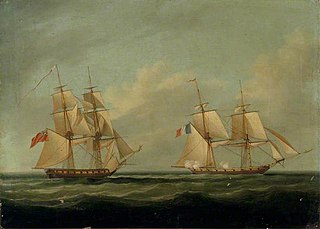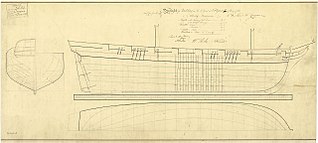
HMS Forester was a Royal Navy 18-gun Cruizer-class brig-sloop built by John King and launched in 1806 at Dover. She had a relatively uneventful career before the Navy sold her in 1819.

HMS Curieux was a French corvette launched in September 1800 at Saint-Malo to a design by François Pestel, and carrying sixteen 6-pounder guns. She was commissioned under Capitaine de frégate Joseph-Marie-Emmanuel Cordier. The British captured her in 1804 in a cutting-out action at Martinique. In her five-year British career Curieux captured several French privateers and engaged in two notable single-ship actions, also against privateers. In the first she captured Dame Ernouf; in the second, she took heavy casualties in an indecisive action with Revanche. In 1809 Curieux hit a rock; all her crew were saved but they had to set fire to her to prevent her recapture.
Two vessels have been named His Majesty's hired armed cutter Earl St Vincent.
HMS Elk was a Cruizer-class brig-sloop, built of pine, and launched in 1804. She served on the Jamaica station where she captured a number of privateers. She was broken up in 1812.
HMS Fleur de la Mer was the French privateer Gipsey, captured in 1806. The British Royal Navy bought her in 1807 and she served until she foundered in 1810.

HMS Pandora was launched in 1806. She captured two privateers before she was wrecked in February 1811 off the coast of Jutland.

HMS Julia was a British Royal Navy 16-gun brig-sloop of the Seagull class launched in February 1806. After a fairly uneventful decade-long career she was wrecked at Tristan da Cunha in 1817 with heavy loss of life.

HMS Moselle was a Cruizer-class brig-sloop of the Royal Navy, launched in 1804. She served during the Napoleonic Wars in the Mediterranean, the Caribbean, and the North American station. She was sold in 1815.

HMS Columbine was a Cruizer-class brig-sloop launched in 1806. She served on the North America station, in the Mediterranean, off the Portuguese coast, and in the West Indies during the Napoleonic Wars. In 1823 she served briefly off Greece before wrecking off the Peloponnese in 1824.

HMS Crocus was the nameship of the Crocus-class brig-sloops of the Royal Navy. She was launched in 1808 and had an almost completely uneventful career until she was sold in 1815. She then became a merchantman trading with the West Indies and the Mediterranean. She was last listed in 1823.
HMS Port d'Espagne was a 14-gun vessel, variously described as a sloop, gun-brig or schooner, built in 1806 in Trinidad, whose citizens presented her to the crown. She captured several small Spanish privateers and participated in a major campaign before she was sold in 1811.
HMS Diligent was the French naval brig Diligent, launched in 1800, that HMS Renard captured in 1806. The Royal Navy took her into service under her existing name, which it later changed, first to Prudente, and then to Wolf. During her two years of active duty with the Royal Navy she captured two small privateers. Wolf was laid up in 1808 and sold in 1811.
The French brig Griffon, was a Pallinure-class brig launched in 1806. After HMS Bacchante captured Griffon in 1808, the Royal Navy took her into service. Griffon participated in one action that resulted in her crew being awarded the Naval General Service Medal. Two of her officers were subject to notable courts martial, one for murder and one for smuggling, with the murderer being hanged and the smuggler dismissed the Navy. The Navy sold Griffon in 1819 to Hills & Co., who proceeded to use her as a London-based whaler. She sailed to the South Seas fishery under some under different masters. Hill & Co. then sold her to Wilson & Co. who employed her on one last whaling voyage that ended in 1850.
His Majesty's hired armed ship Charles served the Royal Navy from 17 May 1804 to 13 May 1814. Prize money notices and other accounts referred to her interchangeably as the "hired armed brig", "hired armed ship", and "hired sloop".
The Hired tender Louisa served the British Royal Navy from 24 April 1803 to 1809. She was of 120 1⁄94 tons (bm) and was armed with four 3-pounder guns and six ½-pounder swivel guns.
HMS Saint Christopher was the French privateer Mohawk, launched in 1805, that the Royal Navy captured in 1806. The citizens of Saint Kitts, purchased her and donated her to the Royal Navy. She was broken up at Antigua in 1811.
HMS Curlew was the mercantile sloop Leander, launched at South Shields in 1800. The Royal Navy purchased her in 1803 and named her Curlew as there was already a HMS Leander in service, and the Curlew name was available. Curlew was a sloop of 16 guns. The Navy sold her in 1810 and she returned to mercantile service as Leander. On her first voyage to the West Indies a French privateer captured her in a single-ship action; she was lost shortly thereafter.
HMS Favorite was an 18-gun Cormorant-class ship-sloop, launched in 1806 and broken up in 1821. In her career she sailed as far North America, the Caribbean, Africa, South America, and the Far East. She captured or recaptured several merchant ships and a handful of privateers.
Highlander was launched at Sunderland in 1805 as a West Indiaman, trading with Demerara. She was captured in 1807 after a sanguinary single ship action. One of her passengers was a naval officer repatriating for illness, but who escaped French custody and later rose to be a Rear Admiral. She returned to British ownership and was wrecked in 1809.
HMS Vimiera was launched in 1805 at Havre as the French Navy brig Pylade. The Royal Navy captured her in 1808 and commissioned her. She participated in one campaign that earned her crew a clasp to the Naval General Service Medal. She was laid up in 1810 and sold in 1814.




